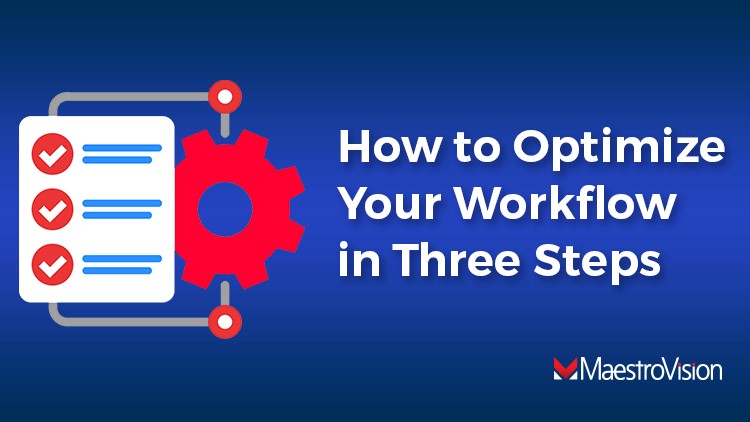Check out our presentation on the topic!
Workflow – it’s not a fun topic to address within your organization, but it’s more necessary than most business owners realize! According to process.st, Only 4% of companies measure, manage and document their processes. If you’re not consistently analyzing and identifying ways to improve your internal workflow, you may experience employee dissatisfaction, leading to high turnover, in turn decreasing productivity and causing more problems.
In this article, we’ll cover:
- What exactly is workflow?
- Why is workflow improvement important in today’s world?
- What steps to follow when improving your workflow.
Before beginning to optimize your workflow, it’s important that you understand what workflow is and is not. Workflow not software or specific technology. Workflow is not a way of moving files or managing. Workflow isn’t an asset manager or file transfer protocol, it’s not a cabling diagram. Workflow is not only a concern of high-level management but affects all levels of an organization. It’s not even specific to the broadcast industry, it’s been used for over 50 years by various industries.
Workflow analysis is about streamlining the way we work. It’s is about information and identifying how it flows between actors. It’s about knowing your business’ needs and solving bottlenecks to save time, money and resources. According to Frevvo, “Workflow analysis is the process of examining your business workflows to identify trends and improve workflow efficiency. In turn, this improves employees engagement, customer satisfaction and the competitiveness of the business itself.”
Several indications that it’s time for your company to undergo a workflow analysis include:
- Employee burnout or frustration with workload or processes
- Internal communication gaps within the company (one department is aware of a new procedure or change while the other isn’t)
- Workload inefficiencies – work isn’t completed on time or employees are constantly working overtime to complete projects
- Processes that should take short amounts of time are taking days or weeks to be completed
- And more….
So why do businesses undergo this rigorous process of investing time and energy into improving their current operations? It’s simple – to save time, money, and resources, increase efficiency and productivity, and increase results. All leading to better return on investment and generating more added value.
There are three phases to workflow optimization.
The first phase: Establishing goals.

Talk with the management and ask about their goals. Are their goals to save money, grow the workforce and avoid organizational inertia, or to reduce the workforce while still maintaining the same workload? Are there new projects that need to be worked on but no additional resources?
Ensure their goals are SMART.
Specific
Bad example: I want our production team to increase their unit output greatly.
Good example: I want our production team to produce 15 more units per week.
Measurable
The best way to ensure you’re measuring your goals is to measure your key performance indicators and understand which indicators will signify that you’ve met your goal. Choosing the correct KPI is also extremely important to avoid inducing unwanted deviant behavior in middle management and employees.
Achievable
Speak with your employees about your expectations and goals before setting them to ensure they’re realistic.
Relevant
Ensure your goal is relevant in that it will assist with process or workflow improvement in your organization. If you assign an unrelated goal that puts even more stress and work on your employees without a plan to improve processes, then it will lead to further internal dissatisfaction and chaos.
Time-Based
Establish a date that you’d like to see that goal met. You may find that after the analysis phase, the timeframe is unrealistic and needs to be adjusted as an optimization timeline is built.
The second phase: Analyzing the situation

Begin your analysis by talking with people involved in your organization. Do not only use a questionnaire. Take copies of existing documentation that explains each employee’s current job responsibilities and get their feedback. Are any responsibilities missing from their job description? When the organization is using competency profiles, are those realistic and up to date? How do they go about getting these tasks done and why?
Oftentimes, there’s a disconnect between what managers think their employees do and what they actually do.
For example, MaestroVision once provided a workflow analysis for a company where employees were extracting information and sending it to a coworker who was formatting a document a report and sending that report to a third email address. That third email address belonged to someone who had taken their retirement two years before.
If you take this example out of context, you may wonder why the employee wasted their time sending that email to someone who was retired. He was sending it because no one told him that the employee was no longer working for the company. This lack of communication indicated a clear break in the communication flow.
So how do you go about identifying bottlenecks and other workflow issues in your organization?
Developing a process map is a great way to illustrate how your current operations are running. It then allows you to identify bottlenecks and inefficiencies.
A few important criteria to consider when conducting your analysis include:
- How is information communicated across your company?
- Shared drive
- Meetings
- Spreadsheets
- Printed reports
- Who is in charge of what tasks?
- If certain tasks or projects require cross-department or collaborative efforts, how are these conducted?
- How do your employees manage their tasks and duties? How do they keep track of what they have to do and when?
- What are your employee’s thoughts on the current way they’ve been trained to complete tasks? Do they have suggestions for making their jobs easier and saving time getting tasks done without compromising company standards?
The third phase: Proposing and implementing improvements.

The best group to present your findings to first are the workers. By presenting your findings to the workers first, you can validate your findings. The workers will be able to point out mistakes that you did so you can correct them and make sure that your understanding of how they currently work is accurate.
Next, do a presentation for management. It’s important to ensure that they share your views and from there, establish a timeline for making your proposed changes/action items. These action items may include (but are not limited to): additional training for employees; new processes or procedures involving project or work management, changes in work distribution or delegation; developing manuals or checklists that are shared internally to ensure company standards are met; obtaining new software to solve inefficiencies or miscommunication; automating a task that is time-consuming and tedious for employees who have more important work to be done, and more.
Before moving on to developing a plan, it’s important that you ensure you have the resources (budget for new software; time for training, etc) to implement the changes you’d like to. If you’ve verified that you have the proper resources, you can build your project plan. Begin by determining an action item dedicated to fixing a weakness that was identified during the analysis phase. In your new project plan, action items should be listed in order; first listing the actions which can be implemented immediately, then listing the ones that will need to be slowly phased into the company’s processes over time.
Before rolling out an entirely new set of processes, it’s important to test your larger-scale changes with a small sample group. Run several tests to check for consistency in results and identify issues that may arise during these new processes. Next, collect feedback from your sample group to determine whether further improvements can be made. After you’ve completed the testing phase, you can move on to the monitoring and optimizing phase. During this phase, it’s important that you test the results of the new process against the goals you determined in the first phase. Continually track and optimize your processes to ensure you’re exceeding KPIs or benchmarks and that your improvements are making a positive difference in the company.



